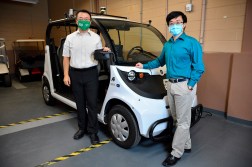California publishes revised autonomous vehicle regulations, highlights federal authority

After initial publication of its proposed regulations for autonomous vehicles in March, the California Department of Motor Vehicles (CA DMV) released on Wednesday revised regulations that officials say will likely become effective by June 2018.
The new regulations emphasize the state’s recognition of federal authority in the development and enforcement of standards for motor vehicles and clarify local reporting requirements for vehicle testing without a human operator present. In a call with the press, CA DMV Chief Counsel Brian Soublet emphasized that the state is following the lead of the National Highway Traffic Safety Administration, which released a new federal guidance for autonomous vehicles in September.
“The regulations continue to require the manufacturers to certify they’re meeting federal safety standards as a prerequisite both for testing and deployment on our streets and roads,” Soublet said.
The updated rules signify a step forward for an industry eager to release its technology to market as federal legislators allow the SELF DRIVE Act to breeze through Congress. California, often a leader in transportation initiatives, now provides a template for local regulation that other states may soon follow.
The revised regulations also clarify to which local authorities manufacturers must notify when they are planning to test autonomous vehicles without a human operator, which cites “local authorities” as defined by California Vehicle Code 385. That code states that “‘local authorities’ means the legislative body of every county or municipality having authority to adopt local police regulations.”
Manufacturers are also required to specify in their local notification the specific roads, dates and times when and where testing will occur.
The revised regulations follow a 45-day public comment period during which manufacturers, consumer advocates, local governments, insurance companies and other stakeholders noted areas of the regulations they found troublesome. One was a proposal to require a new application whenever there was “a material change” to the manufacturer’s technology.
Manufacturers complained that this requirement was “overly broad” and potentially prohibitive to their development and testing cycle, and in response the CA DMV adjusted the regulation so that a new application must only be filed if a technology change meets one of a certain set of conditions, such as a change in the vehicle’s SAE level — a standard measurement for the level of autonomy a vehicle possesses.
The release of the revised regulations open a new comment period, which closes on Oct. 25.
Soublet reported that the CA DMV will attempt to submit its final regulations following this comment period to the Office of Administrative Law (OAL) by the end of the year and that the new regulations are expected to become effective by June 2018, contingent on legal approval by OAL.






